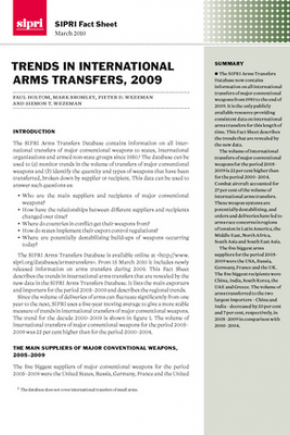Trends in International Arms Transfers, 2009
The SIPRI Arms Transfers Database now contains information on all international transfers of major conventional weapons from 1950 to the end of 2009. It is the only publicly available resource providing consistent data on international arms transfers for this length of time. This Fact Sheet describes the trends that are revealed by the new data.
The volume of international transfers of major conventional weapons for the period 2005–09 is 2022 per cent higher than for the period 2000–2004. Combat aircraft accounted for 27 per cent of the volume of international arms transfers. These weapon systems are potentially destabilizing, and orders and deliveries have led to arms race concerns in regions of tension in Latin America, the Middle East, North Africa, South Asia and South East Asia.
The five biggest arms suppliers for the period 2005–2009 were the USA, Russia, Germany, France and the UK. The five biggest recipients were China, India, South Korea, the UAE and Greece. The volume of arms transferred to the two largest importers—China and India—decreased by 20 per cent and 7 per cent, respectively, in 2005–2009 in comparison with 2000–2004.




